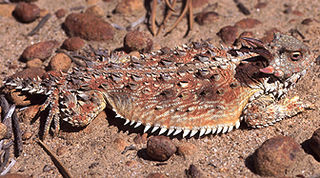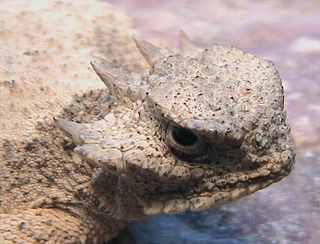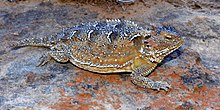
Phrynosoma, whose members are known as the horned lizards, horny toads, or horntoads, is a genus of North American lizards and the type genus of the family Phrynosomatidae. Their common names refer directly to their horns or to their flattened, rounded bodies, and blunt snouts.

The thorny devil, also known commonly as the mountain devil, thorny lizard, thorny dragon, and moloch, is a species of lizard in the family Agamidae. The species is endemic to Australia. It is the sole species in the genus Moloch. It grows up to 21 cm (8.3 in) in total length, with females generally larger than males.

The Texas horned lizard is one of about 21 North American species of spikey-bodied reptiles called horned lizards, all belonging the genus Phrynosoma. It occurs in south-central regions of the US and northeastern Mexico, as well as several isolated introduced records and populations from Southern United States. Though some populations are stable, severe population declines have occurred in many areas of Texas and Oklahoma. The Texas spiny lizard may be confused for a Texas horned lizard due to its appearance and overlapping habitat.

The desert horned lizard is a species of phrynosomatid lizard native to western North America. They are often referred to as "horny toads", although they are not toads, but lizards.

The coast horned lizard is a species of phrynosomatid lizard endemic to Baja California Sur in Mexico. As a defense the lizard can shoot high pressure streams of blood out of its eyes if threatened.
The rock horned lizard, also known commonly as Ditmars' horned lizard and camaleón de roca in Mexican Spanish, is a species of lizard in the family Phrynosomatidae. The species is endemic to the Mexican state of Sonora, in northern Mexico, south of the Arizona border. Bearing the shortest horns of all the horned lizards, it lives in thorn-scrub and deciduous Sinaloan woodlands. The rock horned lizard was "lost" to science for about 65 years. It has a unique habitat preference and limited distribution. It also had a very imprecise holotype locality record which made it difficult to locate. An extraordinary effort by Vincent Roth based on a cross-correlational analysis of gut contents from only three specimens led to its rediscovery.

The flat-tail horned lizard is a species of lizard in the family Phrynosomatidae. A species of reptile, it is endemic to the Sonoran desert of the southwestern United States and northwestern Mexico. Its multiple adaptations for camouflage help to minimize its shadow. The species is threatened, with a restricted range under pressure from human activities such as agriculture and development, and is specially protected in the United States.

The roundtail horned lizard is one of the smaller species of horned lizard. Their specific epithet is from the Latin word modestum, meaning modest or calm. They are found in the United States, in western Texas, New Mexico eastern Arizona, southeastern Colorado and eight states in northcentral Mexico where they are referred to as "tapayaxtin".

The Mexican Plateau horned lizard is a species of horned lizard in the family Phrynosomatidae. The species, also known commonly as the Chihuahua Desert horned lizard, is endemic to Mexico. There are five recognized subspecies. The specific epithet, orbiculare, comes from the Latin adjective orbis, meaning "circular".
The northern desert horned lizard is a subspecies of the desert horned lizard, along with the southern desert horned lizard. It is often referred to as a "horny toad" due to its wide body and blunt snout, but it is not a toad.

Autohaemorrhaging, or reflex bleeding, is the action of animals deliberately ejecting blood from their bodies. Autohaemorrhaging has been observed as occurring in two variations. In the first form, blood is squirted toward a predator. The blood of these animals usually contains toxic compounds, making the behaviour an effective chemical defence mechanism. In the second form, blood is not squirted, but is slowly emitted from the animal's body. This form appears to serve a deterrent effect, and is used by animals whose blood does not seem to be toxic. Most animals that autohaemorrhage are insects, but some reptiles also display this behaviour.

The regal horned lizard is a horned lizard species native to Mexico and the Southwest United States.
Wyoming is home to 12 amphibian species and 22 species of reptiles.

The pygmy short-horned lizard is a species of small horned lizard in the family Phrynosomatidae. The species is native to the northwestern United States and adjacent southwestern Canada. Like other horned lizards, it is often called a "horned toad" or "horny toad," but it is not a toad at all. It is a reptile, not an amphibian.

The San Diego horned lizard or Blainville's horned lizard is a species of phrynosomatid lizard native to southern and central California in the United States and northern Baja California in Mexico.
Baur's short-horned lizard is a species of small horned lizard that is endemic to the United States.
The Sonoran horned lizard, also known commonly as Goode's desert horned lizard and el camaleón de Sonora in Mexican Spanish, is a species of horned lizard in the family Phrynosomatidae. The species is native to Arizona in the United States and to Sonora in Mexico.
















